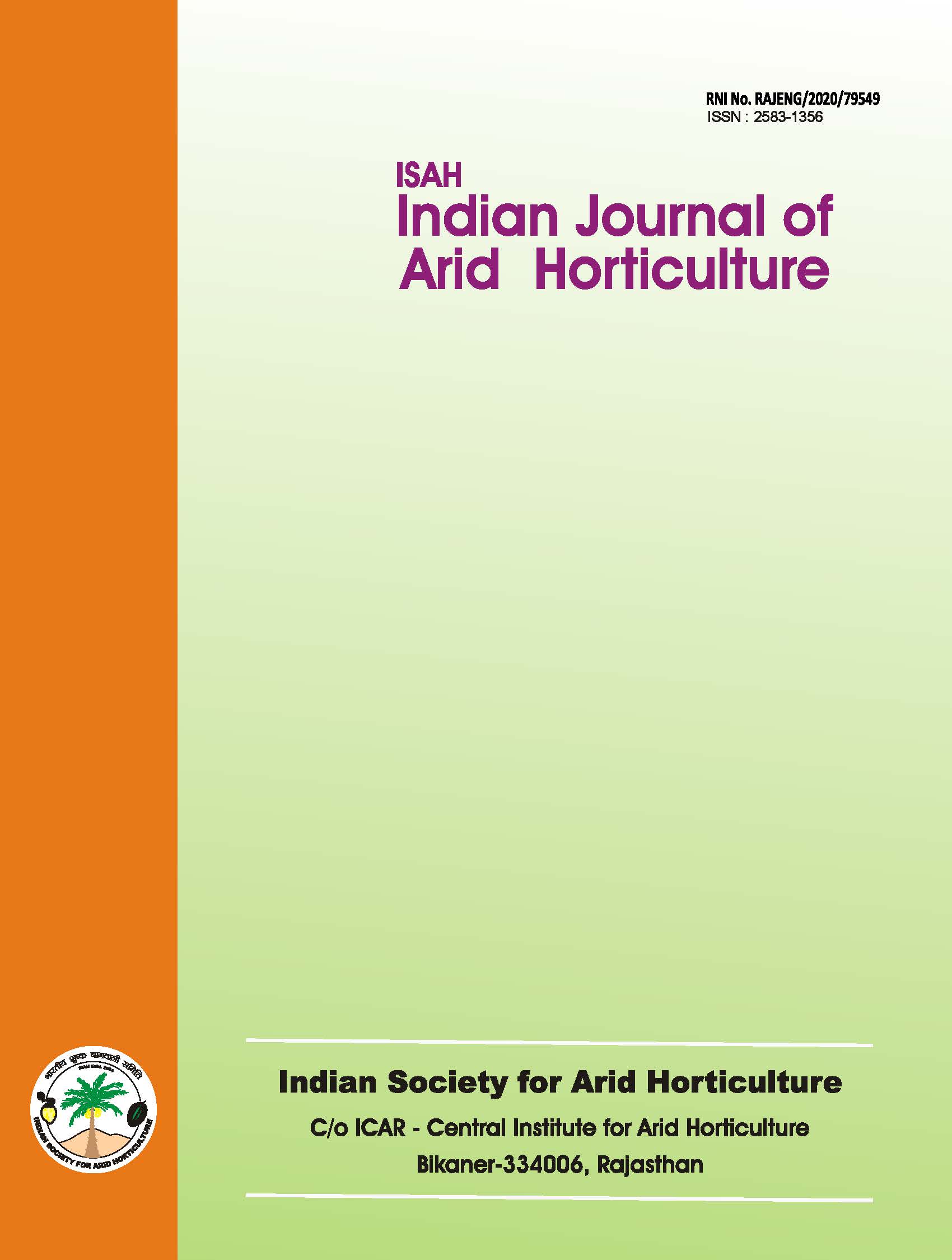Effect of growth regulators on floral malformation in mango (Mangifera indica L.) cv. Amrapali
Keywords:
Mango, Auxin,, Ethrel, Panicles, Floral malformation, Inflorescence.Abstract
Mango is a unique species in fruit trees with respect to growth, specific nature and diversity. Like other crops, it is prone to various biotic and abiotic stresses being major obstacle to mango production. Amongst biotic and abiotic problems of mango, Floral malformation has become a crux with yield losses ranging from 60% to 80. A field experiment was conducted to assess the effect of auxin and ethrel on floral malformation in mango. Studies were undertaken on 18 years old mango trees of Amrapali. The selected trees were sprayed "on year" with different concentration of auxin (NAA) viz. 150 ppm, 175 ppm & 200 ppm., etheral viz. 300 ppm, 400 ppm & 500 ppm and distilled water in the first week of October. The result revealed that PGR particularly NAA@ 200ppm had significantly effect on maximum (65.92) percentage of healthy inflorescences per shoot and (21.46) percentage of hermaphrodite flowers per inflorescence as compared to rest concentrations of PGRS. Similar this PGR spray showed highest 3.42 and 0.63 average number of fruits set and retention per panicles, respectively followed by ethrel @ 500 ppm. While the lowest hermaphrodite flowers, fruits set and retention per panicle was found in control (distilled water spray), but under this treatment maximum percentage (75.96) of male flowers per inflorescence was noted. From the above study, it can be concluded that exogenous spray of NAA @ 200 ppm applied before flower and fruit bud differentiation can reduce the malformed panicles to the extent of about seventeen percent. Perfect flowers (hermaphrodite) can also be increased both in normal as well as malformed panicles which helpful for higher fruits set and retention per panicle.Downloads
References
Anonymous, 2014. 2nd Advance Estimate of Area and
Production of Horticulture Crops, NHB, Gurgaon. Chakrabarti, D. K. and Kumar R. 2000. Epidemiological principles of control of mango malformation - A review. Agric. Rev., 21:129132. Chowdhury, M. N. A. and Rahim, M. A. 2008. Effect of concentrations and time of application of NAA on malformation of mango. J. Agrofor. Environ., 2(1):1-
6. Kumar, M. A. and Reddy, Y. N. (2006). Effect of pruning on sex ratio, fruit set retention of fruits and fruit quality in certain varieties of mango. Journal of Research Archarya N.G.Ranga Agriculture University, 34 (2):22-25.
Pandey, D. and Pandey S. N. 1999. Effect of ethrel spray on the incidence of floral malformation and physiological changes in floral buds of mango. Progressive Horticulture, 41(2):171-173. Pandey, D. and Pandey S. N. 2000. Effect of growth regulators and zinc sulphate on floral malformation in mango (Mangifera indica L.) cv. Amrapali. Annals of Agricultural Research, 21 (1)129-32. Pandey, G. and Sant, R. 1995. Effect of malformation on changes in endogenous auxins during floral development of mango. Indian J. Hort., 52(2): 92-
96.
Ram, S. and Singh, D. K., 1998. Effect of auxin, gibberellin
(Control)
and cytokinin on floral malformation and productivity in mango. Recent Horticulture, 14:6-9. Ram, S. and Yadav, V.K. 1999. Mango malformation-A
review. J. Appl. Hort., 1(1): 70-78.
Shahbaz, M. Z. Iqbal, A. Saleem and M. A. Anjum. 2009. Association of Lasiodiplodia theobromae with different decline disorders in Mango (Mangifera indica L.). Pak. J. Bot., 41(1):359-368. Singh, Z. and Singh, L. 1998. Micronutrient levels in
malformed and healthy organs of mango. Journal of Plant Nutrition, 21:2613-2621.
Singh V. K., Misra A. K., Rajan S. and Ansari M. W. 2007.Protein profile, mangiferin and polyphenol oxidase levels in susceptible and tolerant genotypes of mango against malformation. Indian J. Hort., 64:2224.
Singh A., Ansari, M. W., Rani, V., Singh, C. P., Shukla, A., Pant, R. C., Tuteja N. and Bains, G. 2014 First evidence of putrescine involvement in mitigating the floral malformation in mangoes: a scanning electron microscope study, Protoplasm: 251(5):1255-61. Sirohi,S. C., Rana, S. P. and Singh, R. 2005. Response of mango malformation to foliar application of NAA and pesticide. Indian J. Hort., 62 (1): 2224. Wafaa Haggag M., Hazza M., Sehab A. and Abd El-Wahab M. 2011. Mango Malformation: I. Toxin Production Associated with Fusarium Pathogens. American Journal of Plant Sciences, 2:276-281.

